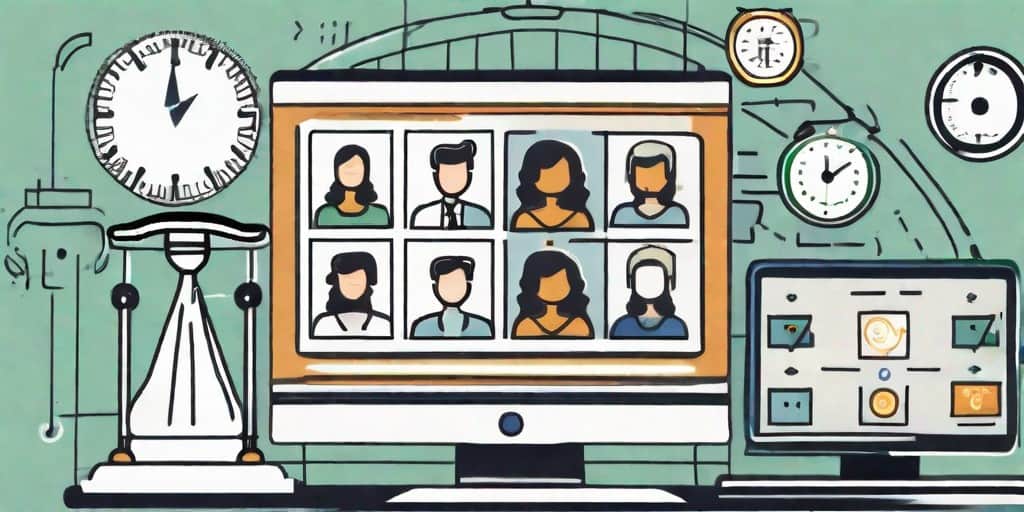In today’s fast-paced digital world, video messaging has become a transformative tool in various industries, including human resources. This technology has revolutionized the way organizations communicate, collaborate, and engage with their employees. In this article, we will explore the benefits and challenges of implementing video messaging in HR, as well as best practices for its effective use.
Understanding Video Messaging in Human Resources
Video messaging has revolutionized the way human resources (HR) departments communicate and collaborate. Over the years, video messaging has evolved from simple pre-recorded videos used for training purposes to real-time video messaging platforms that enhance communication within HR teams and with employees.
The Evolution of Video Messaging in HR
In the early days, video messaging in HR was limited to pre-recorded videos used primarily for training employees. These videos were often generic and lacked personalization. However, with advancements in technology, organizations now have access to sophisticated video messaging platforms that offer a wide range of features.
Today, HR professionals can leverage real-time video messaging platforms to connect with employees in a more engaging and interactive way. These platforms enable HR teams to conduct virtual meetings, host webinars, and provide on-demand training sessions. By utilizing video messaging, HR departments can overcome geographical barriers and connect with employees across different locations.
Furthermore, video messaging platforms have become an essential tool for HR professionals to enhance collaboration within their teams. With the ability to share personalized video messages, HR teams can effectively communicate important updates, announcements, and company policies. This personalized approach fosters a sense of connection and engagement among employees, leading to increased productivity and satisfaction.
Key Features of Video Messaging Platforms
Modern video messaging platforms offer a plethora of features specifically designed to meet the unique needs of HR departments. These platforms go beyond basic video communication and provide HR professionals with powerful tools to streamline their processes and improve employee engagement.
One of the key features of video messaging platforms is the ability to create and share personalized video messages. HR professionals can record videos tailored to specific employees or teams, delivering messages that resonate on a more personal level. This personalized approach helps to build stronger relationships between HR and employees, fostering a sense of trust and understanding.
In addition to personalized video messages, video messaging platforms also enable HR teams to conduct virtual meetings. With high-quality video and audio capabilities, HR professionals can connect with employees remotely, eliminating the need for everyone to be physically present in the same location. This feature is particularly valuable for organizations with multiple offices or remote workers.
Another important feature offered by video messaging platforms is the ability to host webinars. HR professionals can organize webinars on various topics, such as employee wellness, professional development, or company updates. These webinars provide a platform for HR to share valuable information and engage with employees in a more interactive way.
Furthermore, video messaging platforms often come with analytics and reporting capabilities. HR teams can track engagement metrics, such as the number of views, likes, and comments on their videos. This data allows HR professionals to measure the effectiveness of their video communications and make informed decisions to improve future messaging strategies.
In conclusion, video messaging has significantly transformed the way HR departments communicate and collaborate. With the evolution of video messaging platforms, HR professionals now have access to powerful tools that enhance communication, foster engagement, and improve overall employee satisfaction. By leveraging the features offered by these platforms, HR teams can create a more connected and productive workforce.
The Advantages of Video Messaging in HR
Enhancing Communication and Collaboration
Effective communication is the cornerstone of any successful organization. Video messaging provides HR professionals with a more engaging and impactful way to communicate with employees, especially remote teams or those working across different locations. Whether it’s sharing important updates, conducting virtual meetings, or delivering company-wide announcements, video messaging bridges the gap and fosters stronger connections.
Studies show that video content is more memorable and engaging compared to written messages. In fact, research by Forbes found that viewers retain 95% of a message when they watch it in a video, compared to only 10% when reading it in text. By leveraging video messaging, HR teams can effectively convey crucial information while enhancing employee understanding and retention.
Furthermore, video messaging allows HR professionals to add a personal touch to their communication. They can use facial expressions, gestures, and tone of voice to convey emotions and build rapport with employees. This human element in video messaging helps to establish trust and strengthen relationships, ultimately leading to improved collaboration and teamwork.
Streamlining Recruitment and Onboarding
Recruitment and onboarding processes can often be time-consuming and resource-intensive. Video messaging platforms offer a streamlined approach to these essential HR functions. HR professionals can create and share video job postings, showcasing the company culture, job requirements, and attracting the right talent. Additionally, video messaging can be used to conduct virtual interviews, saving both time and travel expenses.
Once new employees are hired, video messaging plays a vital role in the onboarding process. Instead of lengthy, text-heavy documents, HR teams can create interactive onboarding videos that introduce company policies, procedures, and provide insights into the organization’s values and mission. This not only enhances the new employee’s understanding but also increases engagement during the crucial early stages of employment.
Moreover, video messaging allows HR professionals to create a sense of belonging and connection for new hires, even before they step foot in the office. They can create welcome videos from team members, showcasing the company culture and introducing colleagues virtually. This personalized approach helps new employees feel valued and welcomed, setting the stage for a positive onboarding experience.
Boosting Employee Engagement and Training
Employee engagement is a key driver of productivity, satisfaction, and retention. Video messaging offers innovative ways to boost employee engagement throughout the organization. HR professionals can create video newsletters or updates, providing a more engaging approach to sharing company news, updates, and achievements. These videos can be coupled with interactive features such as quizzes or surveys to gauge employee understanding and feedback.
Additionally, video messaging is an effective tool for employee training and development. Complex topics can be explained visually, increasing comprehension and knowledge retention. Whether it’s delivering product training or facilitating professional development sessions, video messaging platforms provide a flexible and accessible medium for HR teams to deliver valuable content to employees.
Furthermore, video messaging allows for asynchronous learning, meaning employees can access training videos at their convenience, eliminating scheduling conflicts and ensuring consistent access to learning resources. This flexibility empowers employees to take ownership of their professional development and enhances their overall engagement with the organization.
In conclusion, video messaging in HR offers numerous advantages, ranging from enhancing communication and collaboration to streamlining recruitment and onboarding processes, and boosting employee engagement and training. By leveraging the power of video, HR professionals can create a more engaging, impactful, and efficient HR experience for employees, ultimately driving organizational success.
The Challenges of Implementing Video Messaging in HR
Implementing video messaging in HR requires a reliable and robust technical infrastructure. Bandwidth limitations, network connectivity issues, and compatibility concerns can hinder the effective use of video messaging platforms. Organizations must ensure that their IT infrastructure can support the increased video traffic and provide seamless access to these platforms.
One of the main technical difficulties organizations face when implementing video messaging in HR is bandwidth limitations. Video messages require a significant amount of data to be transmitted, and if the organization’s network is not equipped to handle this increased traffic, it can lead to slow or interrupted video playback. This can be frustrating for both the sender and the recipient, as important information may be missed or misunderstood.
In addition to bandwidth limitations, network connectivity issues can also pose a challenge. If employees are located in different offices or remote locations, they may experience poor internet connectivity, which can affect the quality of video messages. This can result in pixelated or frozen video, making it difficult for employees to fully understand the message being conveyed.
Compatibility concerns are another obstacle organizations must overcome when implementing video messaging in HR. Different video messaging platforms may have varying requirements in terms of software, hardware, and operating systems. Ensuring that all employees have access to the necessary equipment and software can be a logistical challenge, especially in larger organizations with diverse technology setups.
Privacy and Security Concerns
When it comes to video messaging, privacy and security are paramount. HR teams handle sensitive employee information, and it is crucial to safeguard this data when using video messaging platforms. Organizations should implement industry-standard encryption protocols, access controls, and secure storage solutions to protect confidential information.
One of the main privacy concerns organizations face when implementing video messaging in HR is the potential for unauthorized access to video messages. If the video messaging platform does not have adequate security measures in place, there is a risk that sensitive information shared in video messages could be intercepted by unauthorized individuals. This can lead to breaches of employee privacy and potentially legal repercussions for the organization.
Another privacy concern is the storage and retention of video messages. HR teams often need to keep records of employee communications for compliance purposes, but it is essential to ensure that these records are stored securely and in compliance with applicable data protection regulations. Implementing secure storage solutions, such as encrypted servers or cloud-based storage with strict access controls, can help mitigate these privacy concerns.
Overcoming Resistance to Change
Implementing any new technology often faces resistance from employees accustomed to traditional communication methods. HR professionals should proactively address employee concerns and provide comprehensive training to ensure a smooth transition. Demonstrating the benefits and ease-of-use of video messaging can help overcome resistance and foster a more receptive culture within the organization.
One common concern employees may have when transitioning to video messaging in HR is the fear of being misunderstood or misinterpreted. In face-to-face communication, individuals can rely on non-verbal cues, such as facial expressions and body language, to convey their message effectively. Video messaging may not capture these non-verbal cues as accurately, leading to potential misunderstandings. HR professionals can address this concern by providing guidelines on how to effectively communicate through video messages and encouraging employees to be mindful of their tone and body language.
Another resistance to change may stem from a lack of familiarity with video messaging platforms. Some employees may feel overwhelmed or intimidated by the idea of using new technology. Providing comprehensive training and support can help alleviate these concerns and build confidence in using video messaging. HR professionals can conduct workshops or provide online tutorials to familiarize employees with the features and functionalities of the video messaging platform, ensuring they feel comfortable using it for their communication needs.
Best Practices for Using Video Messaging in HR
Video messaging has become an increasingly popular tool for HR professionals to effectively communicate with employees. Whether it’s for training purposes, company updates, or employee engagement initiatives, utilizing video messaging platforms can greatly enhance HR practices. However, to ensure successful implementation and usage, there are several best practices that HR teams should consider.
Selecting the Right Video Messaging Platform
Not all video messaging platforms are created equal. When selecting a platform for HR use, organizations must consider factors such as ease of use, scalability, integration capabilities, and security features. Conducting thorough research, reading user reviews, and consulting with industry experts can help HR teams make an informed decision that aligns with their specific needs and objectives.
For example, some platforms may offer advanced analytics and reporting features that can provide valuable insights into employee engagement and video performance. Others may prioritize data privacy and security, ensuring that sensitive HR information remains protected. By carefully evaluating different platforms, HR professionals can choose the one that best suits their requirements.
Training Staff for Effective Use
Technology is only as effective as the people using it. HR professionals should receive comprehensive training on utilizing video messaging platforms to their full potential. This includes familiarization with features, best practices for creating engaging videos, and understanding the analytics and reporting capabilities of the platform. Training should be an ongoing process to ensure continued proficiency and adaptation to new updates.
Moreover, HR teams should also consider providing training to employees who will be creating and sharing videos within the organization. By equipping employees with the necessary skills and knowledge, they can create impactful videos that effectively convey HR messages and engage their colleagues.
Establishing Video Messaging Policies and Guidelines
Clear policies and guidelines on the use of video messaging platforms are essential to ensure consistency and professionalism within the organization. HR teams should establish guidelines for creating and sharing videos, including brand guidelines, content approval processes, and rules for appropriate use.
These policies should also address data privacy and security concerns to protect both the organization and its employees. For instance, guidelines can outline how sensitive HR information should be handled and stored, as well as the appropriate measures to be taken to ensure data protection.
Furthermore, HR teams can establish guidelines for video content, ensuring that videos align with the organization’s values and objectives. This can help maintain a consistent brand image and prevent any potential issues that may arise from inappropriate or misleading videos.
In conclusion, incorporating video messaging into HR practices can greatly enhance communication and engagement within an organization. By selecting the right platform, providing comprehensive training, and establishing clear policies and guidelines, HR professionals can effectively leverage video messaging to achieve their goals and create a more connected and informed workforce.
The Future of Video Messaging in Human Resources
The video messaging landscape continues to evolve, presenting new opportunities for HR professionals. Augmented reality (AR) and virtual reality (VR) technologies hold promise for immersive training experiences, while live streaming features allow for real-time communication with employees across multiple locations. Staying abreast of emerging trends enables HR teams to leverage the latest innovations in video messaging to enhance their HR initiatives.
One emerging trend in video messaging is the use of AR and VR technologies for training purposes. With AR, HR professionals can create interactive training modules that overlay digital information onto the real world, providing employees with a hands-on learning experience. VR, on the other hand, allows employees to immerse themselves in simulated environments, enabling them to practice skills and scenarios in a safe and controlled setting.
Another exciting development in video messaging is the integration of live streaming features. This technology enables HR professionals to conduct virtual meetings and training sessions with employees located in different parts of the world. Through live streaming, HR teams can foster real-time communication and collaboration, breaking down geographical barriers and promoting a sense of unity among employees.
The Role of AI and Machine Learning in Video Messaging
Artificial intelligence (AI) and machine learning (ML) are transforming video messaging in HR. These technologies can automate processes such as video captioning, language translation, and video analytics, streamlining HR tasks and delivering a more personalized user experience. By harnessing the power of AI and ML, HR professionals can optimize the efficiency and effectiveness of their video messaging campaigns.
AI-powered video captioning, for example, can automatically generate accurate and synchronized captions for HR training videos. This not only ensures accessibility for employees with hearing impairments but also improves overall comprehension and retention of information. ML algorithms can also analyze video content and provide valuable insights on employee engagement, allowing HR professionals to tailor their messaging strategies to better resonate with their audience.
Furthermore, AI and ML can facilitate language translation in video messaging, enabling HR teams to communicate with a diverse workforce more effectively. By automatically translating video content into different languages, HR professionals can ensure that all employees receive important information in a format they understand, fostering inclusivity and promoting a sense of belonging.
Preparing for the Next Generation of HR Communication
As technology continues to advance, HR communication methods will undoubtedly evolve. Staying proactive and adaptable is crucial for HR professionals to effectively navigate the ever-changing landscape. By embracing video messaging platforms and continuously exploring innovative ways to engage with employees, HR teams will be well-prepared for the future of HR communication.
One way HR professionals can prepare for the next generation of HR communication is by leveraging data analytics. By analyzing video engagement metrics, HR teams can gain valuable insights into employee preferences and behaviors, allowing them to tailor their messaging strategies accordingly. This data-driven approach ensures that HR communication efforts are targeted and effective, maximizing employee engagement and satisfaction.
Additionally, HR professionals should keep an eye on emerging technologies and trends in the video messaging space. From interactive video platforms to personalized video messages, the possibilities for HR communication are constantly expanding. By staying informed and open to new ideas, HR teams can stay ahead of the curve and deliver impactful messaging that resonates with employees.
Conclusion
In conclusion, video messaging presents significant benefits and challenges for human resources. From enhancing communication and collaboration to streamlining recruitment and boosting employee engagement, video messaging platforms offer innovative solutions to address the evolving needs of HR teams.
While technical difficulties, privacy concerns, and resistance to change may pose challenges, these obstacles can be overcome through robust infrastructure, secure measures, and effective change management strategies.
To fully harness the power of video messaging in HR, it is crucial for organizations to select the right platform, provide comprehensive training, and establish clear policies and guidelines. By doing so, HR teams can unlock the full potential of video messaging and embrace the future of HR communication.
Ready to experience the transformative benefits of video messaging in your HR initiatives?
Start your free trial today and revolutionize the way your organization communicates and engages with its employees.







